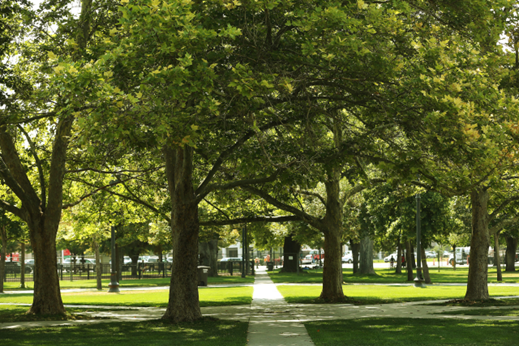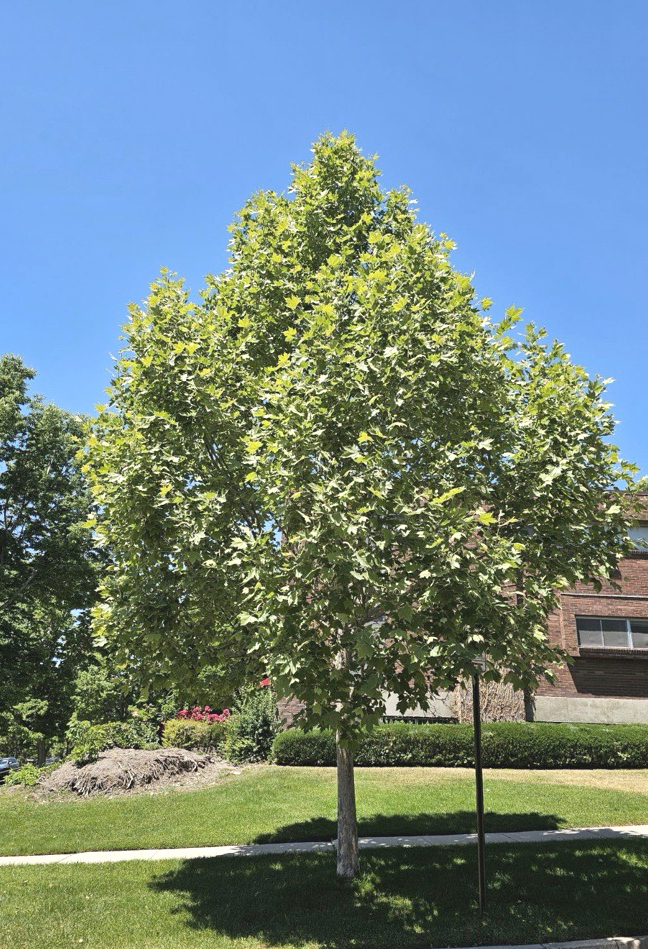
Choosing the Right Tree for the Right Place
— Quick Links —
Are you planning to add a tree to your park strip? Review the information below to ensure you choose the right tree and follow City requirements to ensure the health of your tree.
Keep in mind, Salt Lake City Urban Forestry strives to plant 1,000 new trees each year to maintain a healthy thriving urban forest. When trees are removed, replanting will generally occur within a year, provided there is adequate space. If there is not a tree in the park strip adjacent to your property and you would like one, call our office and we will perform an evaluation of the site. If there is space, you will be put on the tree-planting list.
Selection Considerations
The right tree for the right place
Trees are lifetime investments. Trees and sites need to be chosen wisely. Trees are vital to public infrastructure, reducing storm water runoff, reducing heat, enhancing property values, and encouraging wildlife habitat. However, trees share space with other public infrastructure requiring thoughtful selection of the right of way.
The right tree
Trees come in all shapes and sizes and can change dramatically from juvenile to maturity over their lifetimes. Making a good selection for the tree’s mature size is important. Choosing the right tree when planting will ensure a healthy tree that is characteristic of its natural shape and form that doesn’t have to undergo unnecessary disfiguring pruning to accommodate utility wires, buildings, signs, or street lights.
The right place
City trees grow in limited spaces alongside public infrastructure like utilities, signs, lights, sidewalks, and driveways. Trees need enough room both above and below ground to grow properly. Planting trees in spaces that fit their mature size prevents problems like raised sidewalks and damaged curbs, which are expensive to fix and can harm the trees.
Size Options
Small Tree Species
Select small species if one or more of the following conditions exist:
- Park strip 3 to 5 feet wide
- Park strip is with or without high voltage transmission lines
- Space for root or canopy growth is limited
Medium Tree Species
Select medium species if one or more of the following conditions exist:
- Park strip is 5-8 feet wide
- Planting site has no overhead high voltage transmission lines
- Intermediate size is compatible with site
Large Tree Species
Select large species if one or more of the following conditions exist:
- Park strip is 8 feet wide or wider
- Planting site has no overhead high voltage transmission lines
- Site will accommodate large tree with maximum size, shade and energy conservation benefits
- Space for root and branch growth will not conflict with site features
Park Strip Tree Planting Requirements
Park strips in Salt Lake City are considered Public Right of Way. Please review the rules below to ensure your planting aligns with the approved criteria.
- All trees planted in the public right of way require a permit issued by the SLC Urban Forestry office.
- All trees planted in the public right of way must be a minimum of 2” caliper in size.
- The site chosen for planting should follow the below criteria:
- 5’ from water meter and/or utility box
- 10’ from fire hydrant
- 5-10’ from residential driveway
- 5-10’ from property line of adjoining parcel
- 5-10’ from non-traffic conducting signage
- 5-10’ from utility pole and/or light
- 20’ from an unregulated intersection (20’ back from intersecting sidewalks)
- 30’ from stop signs
- 30’ from commercial driveway and/or alley
- 40’ from an intersection with traffic lights (40’ back from intersecting sidewalks)
- 15-20’ from a tree that is small in size at maturity (less than 30’ tall)
- 20-30’ from a tree that is medium in size at maturity (30 to 50’ tall)
- 30-40’ from a tree that is large in size at maturity (more than 50’ tall)
- Comprehensive tree planting directions will be provided with all planting permits.
Click here for a list of trees native to Utah. Please note: Most of Utah’s native trees grow in the considerably wetter and colder conditions of Utah’s mountains and may not be suited for urban environments.

Native Tree List
Expand this list to see the full list of native trees.
White Fir
Abies concolor
Large evergreen tree that performs best in moist, cool, protected sites. Shade tolerant. Needs protection to do well if plating area is windy and exposed. Does not like high soil pH. Beautiful landscape addition in favorable location.
Rocky Mountain Maple
Acer glabrum
Small deciduous tree best suited to protected mountain streams. Shade tolerant. This shrubby tree is rarely available in nurseries and seldom planted in urban landscapes. Warm valley locations in marked contrast to its preferred habitat.
Bigtooth Maple
Acer grandidentatum
This is the maple that gives Utah foothills and mountains their outstanding fall color. Tolerates high soil pH better than many maples. Intermediate shade tolerance. Suited to our climatic and appears to withstand some drought when planted in the valley.
Boxelder
Acer negundo
A tough large deciduous tree that thrives in moist, deep soils but will also grow on poor soils and stressful sites. Intermediate shade tolerance. Can be weak wooded. Highly adaptable and well suited for wildlife habitat. Box elder bugs have an appetite for seeds from female Box elder trees.
Serviceberry
Amelanchier utahensis
Small tree particularly well suited to mountain canyons. Stature is shrubby usually remaining below 15′ in height. Multi-stemmed round growth habit. Well-drained soils and partial sun is preferred. Birds are attracted to its fruit and mule deer browse its foliage.
Netleaf Hackberry
Celtis reticulata
Small deciduous tree suited to dry foothills and valley locations. Intermediate shade tolerance. Well suited to low-water use landscapes. Slow to moderate growth rate.
Mountain Mahogany
Cercocarpus ledifolius
Broadleaf evergreen found primarily at high-open mountain settings. Shrubby in youth but has potential for large broad shape. Long-lived and slow-growing. Important species for wildlife. Shade intolerant. Seldom used in urban landscapes, but if available would be a welcome addition to the urban landscape. Tolerant of drought.
Desert Willow
Chilopsis linearis
Best suited to warm locations along streams in southwestern Utah. This small shrubby tree is not a true willow but could be used more as small ornamental if temperatures do not get too cold. Shade intolerant.
Douglas Hawthorn
Crataegus douglasii
A small slow growing shrubby deciduous tree with thorns. Good fall color and well suited for riparian wildlife restoration projects. Shade intolerant. Unusual in cultivated landscapes.
Utah Juniper
Juniperus osteosperma
Very tolerant of drought, cold, heat and a wide variety of soil conditions. Shrub-like growth habitat generally smaller than 15′ tall. Shade intolerant. Well suited to low-water and low-maintenance landscapes.
Rocky Mountain Juniper
Juniperus scopulorum
Larger and more upright compared to Utah Juniper. Highly drought resistant. Shade intolerant. Good choice for visual screening, noise buffering, windbreak and adaptability to variety of planting locations.
Engelmann Spruce
Picea engelmannii
Large slow growing evergreen. Performs best in cool, moist, favorable soils Shade tolerant. Uncommon and not well suited to low elevation, warm, or dry locations.
Blue Spruce
Picea pungens
State tree of Utah. Large at maturity. Needs plenty of space to grow, favorable soil, and frequent irrigation. Beautiful variations in color available due to waxy coating of foliage.
Bristlecone Pine
Pinus longaeva
Slow growing and can be very long-lived: some reported to be over 4,000 years old. Tolerant of dry, tough sites but does not do well in shade. Growth habit can be contorted. Great selection for low water and low maintenance landscapes
Lodgepole Pine
Pinus contorta
Large high elevation slow growing evergreen. Can from thick stands in native areas. Shade intolerant and moderately drought tolerant. Could be used where a natural, low maintenance landscape is preferred.
Pinyon Pine
Pinus edulis
Primary and historic component of Utah’s pinyon pine-juniper forest. Small drought tolerant evergreen that produces seeds relished by wildlife and people alike. Well suited to low water, low maintenance, and landscapes that replicate natural settings.
Ponderosa Pine
Pinus ponderosa
Large slow growing evergreen with distinctive cinnamon-colored bark-plates, large cones, and long pine-needles. Possible alternative to more commonly planted Austrian pine.
Narrowleaf Cottonwood
Populus angustifolia
Large deciduous tree with narrow leaves. Native to riparian corridors. Prefers full sun and alluvial soil.
Fremont Cottonwood
Populus fremontii
Very large historic broad-leafed deciduous tree that thrives along water courses. Females can produce considerable amount of cottony-seeds.
Aspen
Populus tremuloides
One of Utah’s most populous and beautiful trees. Does best in cool, moist, mountain locations in the company of other aspens. Distinctive bark, foliage, and fall color. Not a long-lived species.
Chokecherry
Prunus virginiana
Usually small tree or shrub-like with multiple stems. Highly adaptable but prefers alluvial and moist soils. Attractive flowers are followed by fleshy fruits desired by wildlife. Like aspen can regenerate from sprouts and form thickets given favorable conditions and time.
Douglas Fir
Pseudotsuga menziesii
Large evergreen historically used for timber production but with great potential for beautiful addition to urban landscapes where space for growth and water is provided. Not a true fir.
Oak Gambel
Quercus gambelii
Also known as scrub oak this species is most prevalent along the foothills where it provides great fall color, typically forming thickets that are resilient to adverse weather and tolerant of drought. It also is well-suited to urban landscapes where it can grow to be large in size and vibrancy with irrigation provided.
Peachleaf Willow
Salix amygdaloides
Growth habit is usually small, shrubby, multi-stemmed. Found near water. Very shade intolerant. Well suited to riparian restoration and wildlife habitat improvement projects.